In industries like mining, oil and gas, metal forming, woodworking, and manufacturing, wear-resistant materials are critical.
When equipment operates in tough environments, parts must withstand friction, pressure, heat, and corrosion. Two of the most common materials for wear parts are tungsten carbide and steel.
Choosing the right one can affect productivity, costs, and downtime. This article compares tungsten carbide vs. steel in terms of performance, cost, durability, and best applications—helping decision-makers select the right material for their operations.
What Is Tungsten Carbide?
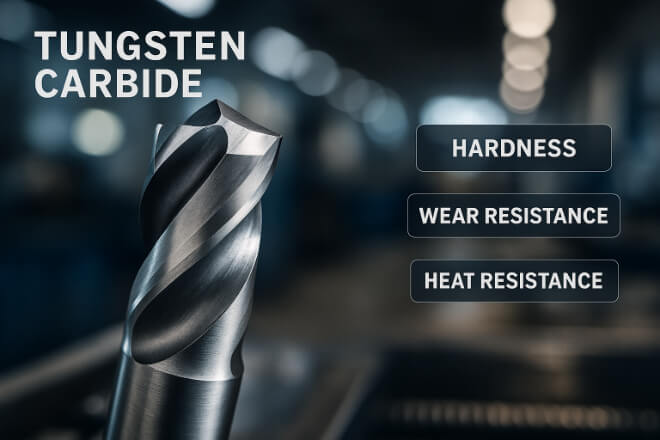
Tungsten carbide is a compound made of tungsten and carbon atoms. It is extremely hard—almost as hard as diamond—while offering good toughness.
This makes it an ideal choice for wear parts that face constant abrasion or extreme conditions.
Key properties of tungsten carbide:
Very high hardness (8.5–9 on Mohs scale)
Excellent wear resistance
High heat resistance
Good corrosion resistance
Long service life
Common uses include cutting tools, mining drill bits, pump seals, wear liners, and precision dies.
What Is Steel?
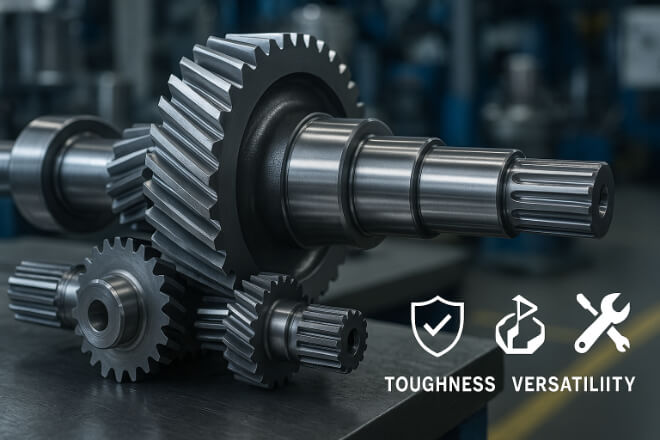
Steel is an alloy made mainly of iron and carbon, often with other elements like chromium, nickel, or manganese to improve performance.
Steel is popular because it’s strong, tough, and versatile. It is also easier and cheaper to machine and weld compared to tungsten carbide.
Key properties of steel:
High toughness and strength
Easier to machine and shape
Cost-effective for large parts
Different grades for different uses (e.g., tool steel, stainless steel, high-carbon steel)
Steel is widely used for gears, shafts, structural parts, and general engineering components.
Tungsten Carbide vs. Steel: Property Comparison
| Property | Tungsten Carbide | Steel |
|---|---|---|
| Hardness | Extremely high (8.5–9 Mohs) | Lower (4–8 Mohs, depending on grade) |
| Wear Resistance | Excellent, ideal for abrasive conditions | Good, but wears faster under abrasion |
| Heat Resistance | Very high, retains hardness at high temps | Moderate, may lose hardness at high temps |
| Corrosion Resistance | High, especially with coatings | Varies — stainless steel resists corrosion well |
| Toughness | Moderate (can chip under heavy shock) | High, better for impact loads |
| Machinability | Difficult, requires diamond or carbide tools | Easy to machine with standard tools |
| Cost | Higher | Lower |
Durability in Harsh Conditions
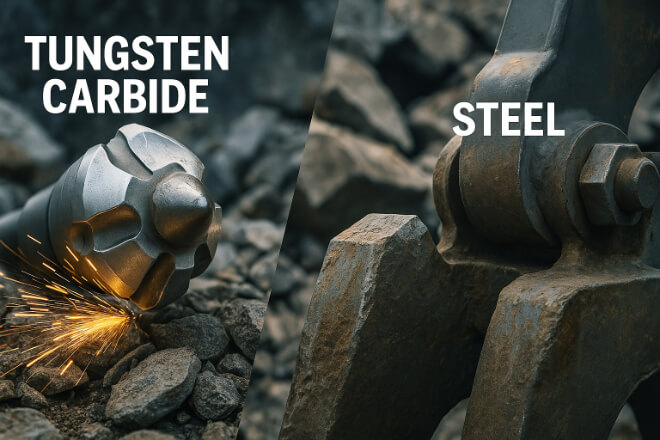
Tungsten carbide shines when it comes to wear and abrasion resistance.
In mining or metal forming, tools and components made of tungsten carbide often last 3–10 times longer than steel equivalents. This reduces downtime and replacement costs.
However, steel can outperform tungsten carbide when parts are exposed to heavy impacts or bending forces.
Steel’s higher toughness means it can absorb shock without cracking, making it better for some structural applications.
Cost Considerations
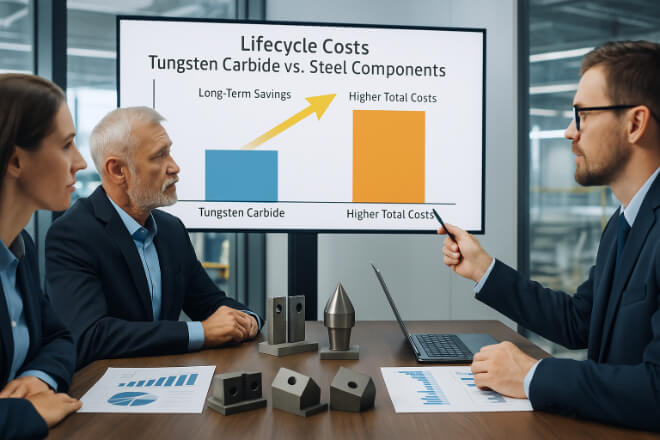
At first glance, tungsten carbide parts cost more than steel. However, when you factor in total life cycle cost—including replacements, downtime, and maintenance—tungsten carbide can often be more economical.
For example, a tungsten carbide cutting die might cost 2–3 times more than a steel die but last 5–10 times longer, making it the better investment in many cases.
Application Suitability
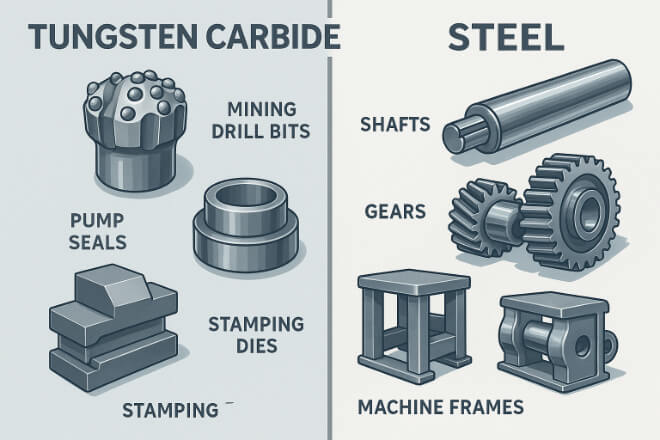
1). When to Use Tungsten Carbide:
Extreme wear and abrasion
High temperatures
Precision tolerances
Continuous operation with minimal downtime allowed
1.1). Examples:
Mining drill bits
Pump seals in oil & gas
Metal stamping dies
Woodworking blades
2). When to Use Steel:
Heavy shock loads and bending
Lower temperature environments
Applications where cost is a key factor
Large parts that would be too expensive in carbide
2.1). Examples:
Machine frames
Shafts and gears
General structural components
Pros and Cons Summary
| Material | Pros | Cons |
|---|---|---|
| Tungsten Carbide | Excellent wear resistance, high hardness, good heat and corrosion resistance, long life | Expensive, brittle under heavy shock, difficult to machine |
| Steel | High toughness, lower cost, easy to machine, versatile | Lower wear resistance, may lose hardness at high temps, needs more maintenance |
Choosing Between Tungsten Carbide and Steel
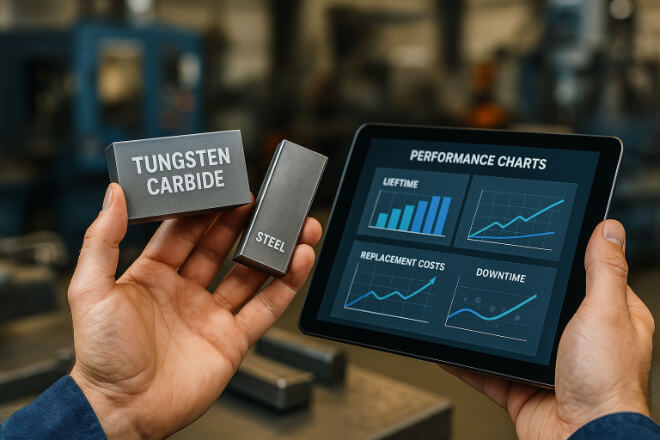
Selecting the right material depends on:
Type of wear – abrasive, adhesive, impact, or corrosive
Operating temperature – high-heat processes may require carbide
Part size – steel is more economical for large parts
Service life requirements – carbide often means fewer replacements
Budget – short-term vs. long-term cost planning
For many industries, the best approach is a combination—using steel for structural support and tungsten carbide for wear surfaces.
Maintenance Tips to Maximize Performance
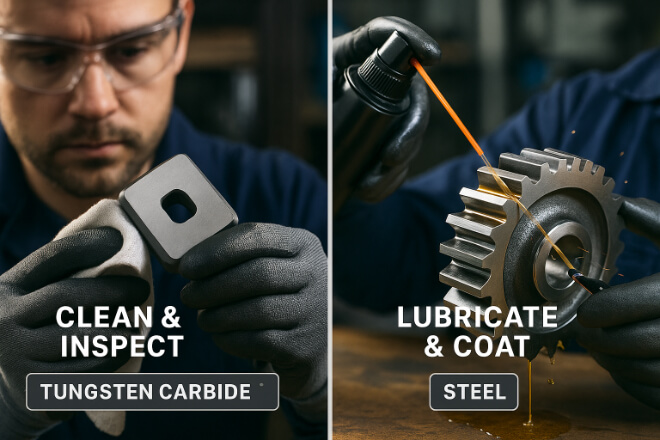
1). For Tungsten Carbide:
Avoid sudden impacts
Use proper mounting to prevent stress cracks
Regularly clean to avoid corrosion from chemicals
2). For Steel:
Apply protective coatings for corrosion resistance
Maintain lubrication to reduce wear
Check for cracks or deformation regularly
Conclusion
In the tungsten carbide vs. steel debate, there is no single winner. Tungsten carbide dominates in wear resistance and high-temperature applications, while steel offers toughness and cost advantages for structural and impact-heavy uses.
Decision-makers should weigh total cost of ownership, performance needs, and operating conditions. In many cases, combining both materials in a single system provides the best of both worlds—durability and toughness.
If you want to know more details about any company, please feel free to contact us.
